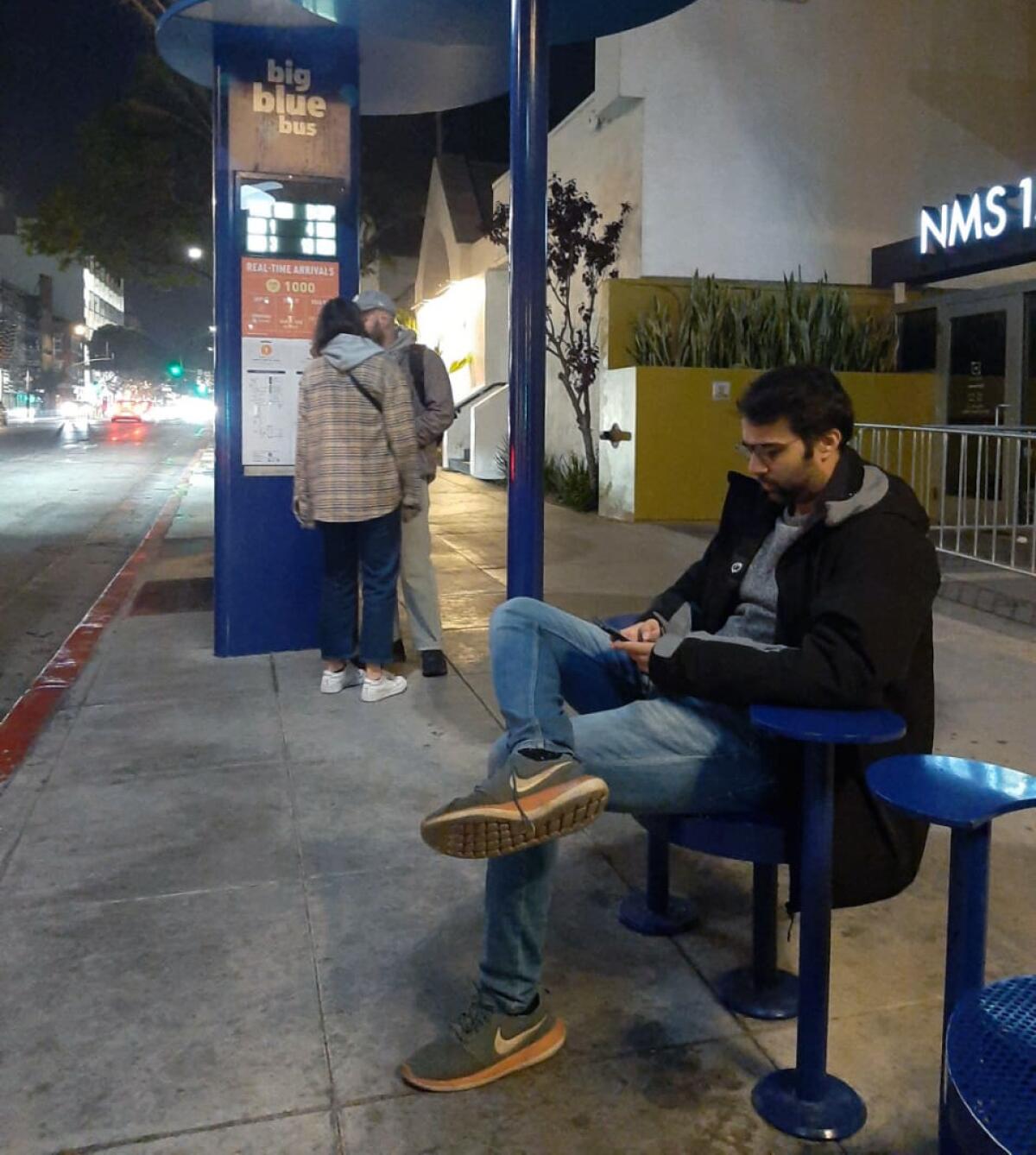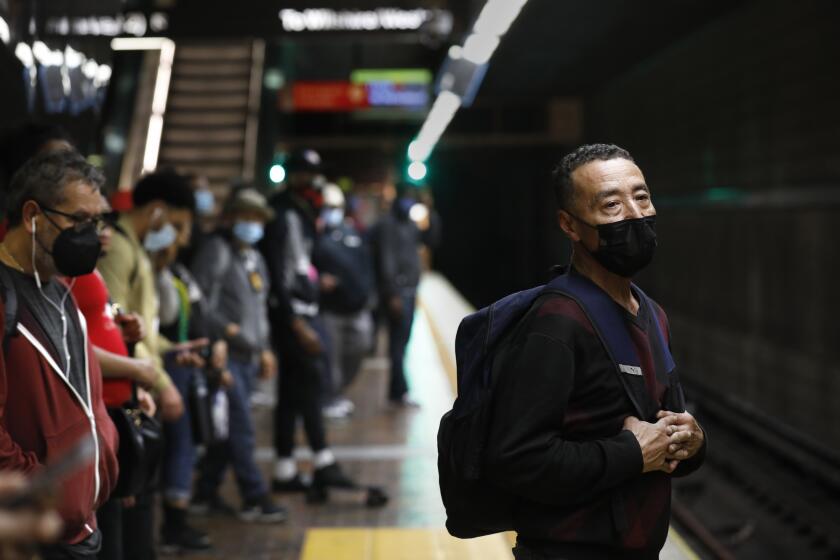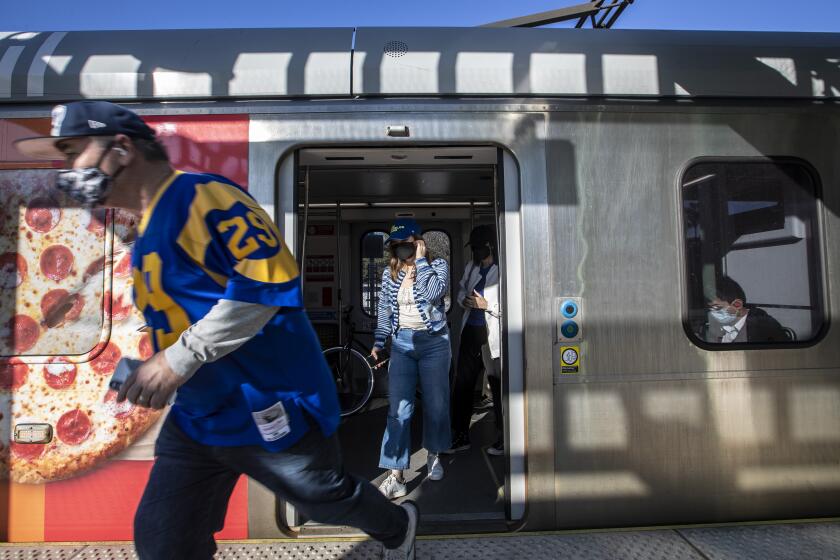Turned away at Del Taco drive-through, high Uber costs: Welcome to life in L.A. without a car

We just finished a late-night grocery run at the Walmart in Lawndale and spotted what, in our state of gnawing hunger, was a glorious red and yellow sign across the parking lot.
Del Taco.
It had been a long day, and my roommate Somesh and I were famished and exhausted. We trudged across the vast empty lot carrying our groceries in giddy anticipation of greasy food. The doors of the Del Taco were locked, but the lights were on and we spotted a worker in the drive-through window. We walked over to scan the lighted menu. I multiplied the prices by 80 to know the cost in rupees — the currency back home in Mumbai — and fixed on one chicken and one beef taco.
We marched up the asphalt drive and knocked on the window.
“I can’t serve you,” the man said.
“What? Why? Are you closed?” I asked.
“You don’t have a car, and this is a drive-through.”
I looked back, there was no car in line or anywhere nearby. The parking lot was desolate. We were not holding anyone up.
“How does that matter?” I asked.
“It does.”
We tried to reason with him, but he had better things to do. He went back to his stool and resumed reading the newspaper. He seemed to have a lot of practice not selling tacos.
I turned to Somesh — we are both 31 years old — completely flummoxed. He half-jokingly suggested pushing me through the drive-through in a Walmart shopping cart. Then we pondered hiring an Uber just to drive us through. But how would that work with our pickup and destination being the same location? Plus it sounded expensive when I thought about it in rupees.
So we walked to our apartment and ate scrambled egg sandwiches.
Before I arrived in L.A. in May for my journalism fellowship with the L.A. Times, a friend of mine had told me it would be tough to survive in the city without a car. I thought it was an exaggeration. It might have been my first time in America, but I have traveled extensively in Europe, where it doesn’t matter if you are close to the city center or not; the metro lines and buses have exquisite connectivity.
Needless to say, they don’t in Los Angeles. Public transport feels completely unencumbered by the burdens of punctuality, availability, geography and safety.
Gasoline prices have reached record highs in Los Angeles, but convincing tens of thousands of Angelenos to leave their gas guzzlers at home is still a hard sell for many.
But it wasn’t until that night at Del Taco that I realized the region’s neglect for the car-deprived borders on hostility.
I was later told that some fast-food places allow drive-through orders only from people in motorized vehicles for security issues. This didn’t add up. Can’t a driver in a car conceal a gun better than a person approaching the restaurant — and all its security cameras — on foot? Can’t a driver simply jump out of his car with this gun when the cashier turns away to grab the food?
Of course they could. I think the whole incident implies that the city looks at people without cars as second-class citizens.
As a visitor, this produced plenty of absurd moments. I didn’t have the navigation skills of a longtime resident without a car to avoid these jams. But coming to the swanky first world city of Los Angeles from India, it was shocking and sad to see how many people had to work with this broken system every day of their lives.
During my time in the L.A. area, I lived in three cities — Lawndale, Inglewood and Santa Monica — and public transit never worked efficiently for me in any of them. I have walked longer than I should have. I have been on buses for hours that would take minutes if they didn’t stop so often. I’ve been on sidewalks that abruptly ended, forcing me to backtrack to cross busy boulevards. I have been in cabs spending 20 times the money I otherwise would because the buses were too slow. I hear there are subways and light rail in L.A., but they weren’t near me. I tried my hand at cycling, but bike lanes were dodgy, traffic was fast and cycling is bloody tiring. I didn’t want to bike 10 miles for every interview I had.
I was in Inglewood when I booked my COVID-19 booster shot at Walgreens. The pharmacy was just over half an hour’s walk from my apartment. It was also a five-minute cab ride, but $14 for five minutes did not seem worth it. I couldn’t stop multiplying by 80. The cab fare is equal to 1120 rupees. With that amount of money, I could travel from one end of Mumbai to another in peak traffic, pay a handsome tip to the driver and still save money for dinner. A cab was out of the question.
Google maps showed another option. There was a bus that would drop me within a five minutes’ walk of Walgreens. That seemed reasonable. What I didn’t notice is that the bus stop was a 25-minute walk from home. When I got there, the bus didn’t arrive for 15 minutes. And I ended up spending more time on the trip than I would have if I had simply walked the whole way.
After I got the shot, I didn’t make the same mistake of looking for the bus. Instead, I made a new one.
There was a supermarket right next to me and I had a list of things we needed. This would save me a haul to my local grocery store. The street-savvy resident might know better. But I ended up buying some of the heaviest items on the list: onions, potatoes, a can of milk, a packet of chicken and more. After having packed it in three bags, I realized my left arm was already getting sore from the injection I had about 25 minutes earlier. I picked up all the bags in my right hand and walked the 30 minutes back to my apartment. It was hot and unshaded. No one apparently bothers to plant trees for pedestrians. But to be fair, they don’t in Mumbai either, and I don’t mind the heat. What I minded was my right arm feeling like it was getting pulled from its socket.
The next morning, that arm hurt more than the boosted one.
California political leaders hope to leverage the 2028 Olympics to infuse billions of federal dollars into Los Angeles transit projects.
You do learn about a place on a bus.
One evening, my roommate and I boarded the bus to go to Redondo Beach. A couple of stops later, an old woman with her dog walked in. She realized we weren’t locals, so she started talking to us. During the small talk, we revealed we were journalists with The Times.
Her face turned red. “The Times should tell the truth,” she shouted.
“When did it lie?” I asked her with a poker face.
For the next 10 minutes, she told us how Dr. Anthony Fauci is a fraud, the COVID vaccines are putting people in danger and The Times hasn’t covered any of it. Redondo Beach couldn’t come sooner.
Although we laughed that off, what happened a couple of weeks later unsettled us. We were on the first of the three buses we would have to take to get to Santa Monica. As our stop approached, we made our way to the back door. A man sat next to the door, relentlessly staring at us. Just when we were about to get off, he asked in a hostile tone, “Are you two Muslims?”
We were taken aback. Ever since we have come to America, we have read about multiple mass shootings and hate crimes. The data also show that gun violence disproportionately affects nonwhite people. I felt extremely unsafe in the moment because I have a bizarre phobia of things that can potentially kill me.
But we maintained our composure. “Is there a problem?” my roommate snapped back. Before the man could respond, we got off the bus and the doors closed behind us. I really wanted a car now.
On the bright side, I have never found it easier to hold a conversation while meeting new people. As soon as I anticipate a moment of awkward silence, I start whining about L.A.’s public transport. That buys me at least five more minutes. It is the story of America — except New York — they tell me.
America has spent trillions on transit in the last century. In 2019, $79 billion in public spending went to it. I remember a line from “Yes Minister,” a British television political satire: “Corruption isn’t government policy. It’s only government practice.” So it’s probably unfair to suggest that American policy is to have bad public transport. It’s just American practice.
Looking back at my time in L.A., it feels like I divided my days between wondering which was more valuable: My time or my stipend. Three months later, I am set to head home having succeeded at saving neither.
The only time I had no doubts about booking a cab was before heading out to report a story.
But one morning, even with a Lyft, I ended up reaching my reporting site 20 minutes late. I was collaborating with Doug Smith for a story from South L.A. Doug had sent me the address the night before. The next morning, the driver said we reached the destination and I called Doug. “Are you in a black car?” he asked. “Yes,” I said, and got out of the car.
There was just one problem. The black car in front of Doug belonged to someone else. And I was three long city blocks away. I ran the rest of the distance and found Doug already two interviews in.
When I meet my family and friends at home, I will share these anecdotes with them in the same tone I have written this column — slightly irritated, largely amused. But I feel for the working class in L.A. According to a Harvard study, commuting time is the strongest factor in escaping poverty. Some people in L.A., in fact, have cars but not homes. Absurd doesn’t even begin to describe it. How good the public transport is says a lot about how much the place cares about its poor. L.A., or America, simply doesn’t.
More to Read
Start your day right
Sign up for Essential California for news, features and recommendations from the L.A. Times and beyond in your inbox six days a week.
You may occasionally receive promotional content from the Los Angeles Times.









